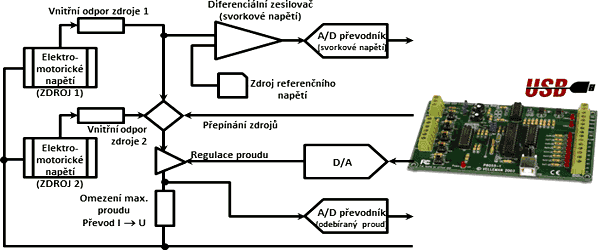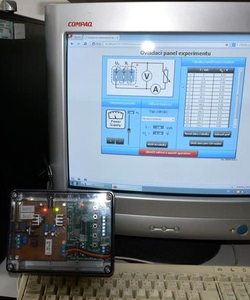Apparatus – Measuring Principle
The measurement of the load characteristic of the source is based on the standard load characteristic measurement shown in Figure 1. It is a closed circuit where we change the load and thus the current drawn from the source. Based on the measurement of several clamp voltage values at different currents, we can obtain a part of the search dependency US (I ). Knowing the linear form of this dependence – formula (5) – all the basic characteristics of the source can be determined. It is also possible to determine the short-circuit current without the need for a real short-circuit - this is not only unhealthy for the battery, but can also explode in some sources (e.g. lithium battery)!

Fig. 1 – Source Load Characteristic and Measurement Scheme
In order to measure the required characteristics, it is therefore necessary to vary the load in the outer circuit, measure the current drawn and also determine the instantaneous value of the terminal voltage. For this measurement, the universal K8055 USB measurement board was again selected. The block diagram of the task is shown in Figure 2. The pair of K8055 analog-to-digital converters is used as the measurement part. The first of the converters is used to read the terminal voltage of the selected source. The second converter reads the voltage across a fixed resistor in the outer circuit. The power resistor with this resistor serves not only as a current-to-voltage converter, but also as a maximum current limiter (to prevent battery shorting).

Fig. 2 – Block diagram of the electronic part of the experiment
To regulate the current drawn from the source, one of the digital-to-analog converters on the K8055 board is used. The adjustable output voltage of the transmitter is a "open" transistor, which limits the current drawn from the source under test. The control range for the batteries used – alkaline and zinc chloride – was selected in the range of 0–300 mA, which allows a relatively large part of the load characteristic. The performance characteristics of the components used have been chosen so that even the long-term load with the maximum operating currents is a fraction of the maximum values of the components – the requirement for 24-hour unattended operation.
To enable the task to be used not only to measure load characteristics, but also to compare two sources of different design, it is equipped with two sources that can be connected to the circuit. A switching relay is used to switch between the alkaline and zinc chloride sources, either to connect the first or the second source. This relay is controlled by one of the digital outputs, which are also on the K8055 board.

The K8055-MARIE network management application was again used for the remote control of the K8055, but this time in the new version 2.5, which was developed during the construction of this remote task at the Technical Olympiad of the Pilsen Region.
Video tutorial
TURN ON THE SUBTITLES IN THE VIDEO TO SEE THE DESCRIPTION AND EXPLANATIONS!








